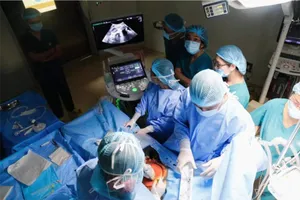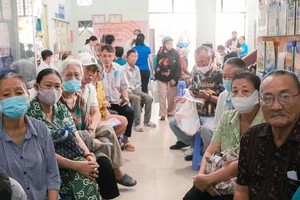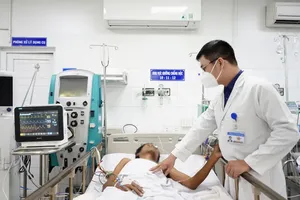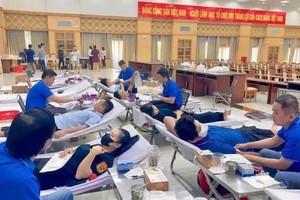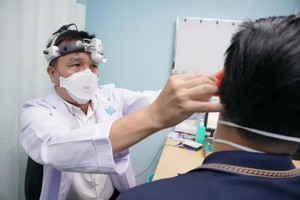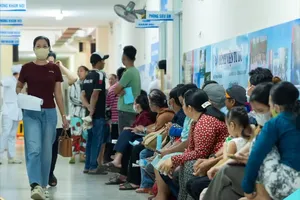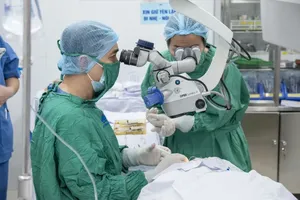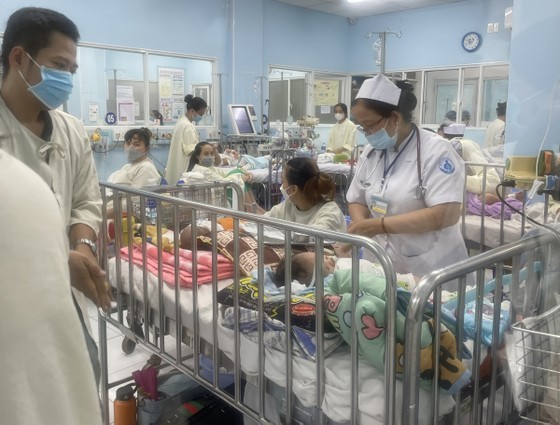
 |
Pediatric hospitals receive more children patients |
People are more likely to get sick when the weather changes. The occurrence of dengue fever, hand, foot and mouth disease, chickenpox, pink eye, respiratory diseases, and influenza at the same time is causing the risk of overlapping epidemics. Worse, these diseases also tend to increase in the number of cases due to the impact of the weather changes.
At Hanoi-based Bach Mai Hospital’s Pediatric Center, in recent days, the number of children hospitalized has increased quite high, causing some treatment rooms to be overloaded. Doctor Nguyen Thanh Nam, Director of the Pediatric Center, said that according to disease epidemiology, in the late October and November periods, children's hospitalizations often increase, especially children under 5 years old, due to the unusual weather change. Most of them usually get respiratory diseases.
The National Pediatric Hospital has also seen an increasing number of children taken to the infirmary for treatment of respiratory diseases and flu. According to Associate Professor Dr. Le Thi Hong Hanh, Director of the National Pediatric Hospital’s Respiratory Center, most children are infected with respiratory syncytial virus with signs of pneumonia, cough, fever, and difficulty breathing; worse, some severe cases have respiratory failure.
Infirmaries in Ho Chi Minh City also reported a dramatic increase in the number of pediatric patients with respiratory diseases. Specifically, Dr. Le Minh Lan Phuong, Head of the Pediatric Hospital 1’s Medical Examination Department, said that every day hospital physicians examine about 4,500 pediatric patients; some days, doctors even have had to see 5,700 children per day, including many children with respiratory diseases whereas a month earlier, the hospital received an average of about 4,200-4,300 pediatric patients every day.
Doctor Nguyen Minh Tien, Deputy Director of the City Pediatric Hospital, said that from the beginning of October until now, the hospital has received nearly 5,000 small outpatients with respiratory diseases such as bronchitis, pneumonia, asthma, bronchial asthma, and acute respiratory infections. Some pediatric patients develop serious conditions and require high-flow oxygen, mechanical ventilation, and even ECMO intervention.
According to doctors, during the changing seasons, the temperature difference between day and night is often very high, which greatly affects the health of children and people with weak immune systems.
Along with the increase in respiratory diseases, a number of other epidemics are still complicated. For instance, recently, two children in Hanoi’s Chuong My and Phuc Tho districts were recorded with Japanese encephalitis. Doctor Nguyen Van Lam, Director of the Center for Tropical Diseases in the National Pediatric Hospital, said that Japanese encephalitis is very dangerous, with a mortality rate of up to 30 percent.
Moreover, according to the doctor, those who are cured of the disease still suffer permanent sequelae such as mental disorders, paralysis, speech disorders, convulsions, and epilepsy. Young children with Japanese encephalitis often have symptoms such as fever, headache, nausea, vomiting, fatigue, and chills. In severe cases, there may be signs of convulsions and reduced cognitive ability.
Meanwhile, the dengue epidemic continues to develop in many localities across the country. According to statistics from the Ministry of Health, the country has currently recorded over 95,000 cases of dengue fever, including 26 deaths. Among localities, the number of dengue cases in Hanoi is still very high. Statistically, from the beginning of 2023 until now, there have been more than 28,400 cases of dengue fever in Hanoi, an increase of 2.7 times compared to the same period in 2022. Four Hanoians succumbed to the fatal disease.
Professor Phan Trong Lan, Director of the Department of Preventive Medicine, pointed out that dengue epidemic prevention is facing many difficulties, requiring anti-epidemic activities to be deployed persistently, continuously and decisively, especially during peak periods, to control the number of infection cases and deaths.
In Ho Chi Minh City, the number of dengue cases decreased by 11 percent compared to last month but is still at a high level. From the beginning of the year until now, Ho Chi Minh City has recorded 15,037 cases of dengue fever. The districts with a high number of dengue cases include District 1, Binh Thanh District and District 8. Meanwhile, the number of hand, foot and mouth disease cases also tends to increase again up 14 percent compared to the previous month. Since the beginning of the year until now, Ho Chi Minh City has recorded 34,521 cases of hand, foot and mouth disease. Districts with a high number of hand, foot and mouth disease cases are Binh Tan , Nha Be and Binh Chanh districts.


